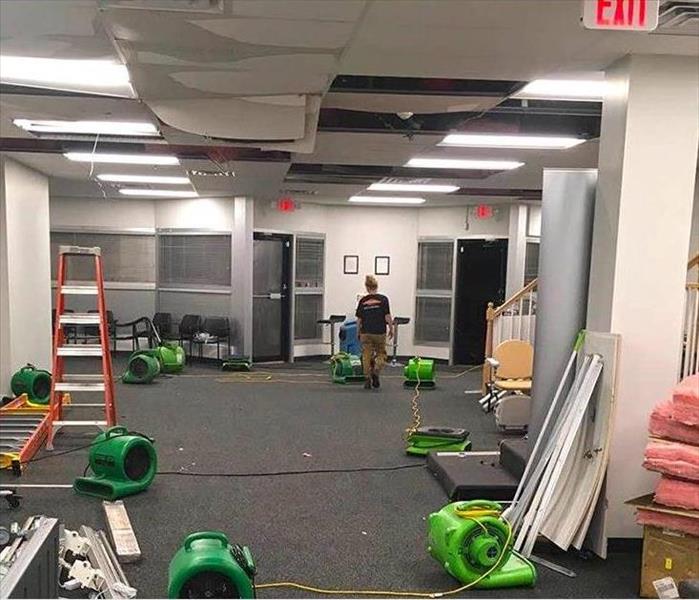Drying After a Water Damage Event
6/22/2021 (Permalink)
 A professional restoration team will know how much equipment to place for proper drying, as well as how to achieve the fastest drying times.
A professional restoration team will know how much equipment to place for proper drying, as well as how to achieve the fastest drying times.
Water damage is a serious threat to your home. Even something as small as a leak from a sink could have serious consequences for the health of your family. One part of the restoration process after water damage is drying. It's easily the most vital part of the recovery process. Here's why.
What is the Drying Process?
The drying process is one of the first steps taken for water damage restoration. It takes place after the water has been removed from the area. Drying can take anywhere from a few hours, for small water problems, to a few weeks, for larger water problems. It depends on how long the problem persisted and the location of the water damage.
Certain materials take longer to dry. Wood, for example, absorbs water. If wood isn't allowed to dry by air or through other means, then it can take several days, if not weeks, for the wood to be fully dried.
Insulation is another material that can take a very long time to dry. It's built to absorb and trap moisture. Too much moisture, like that from water damage, can soak it right to the middle. It can easily take weeks before insulation is fully dry.
There are a few steps you can take to help the drying process occur faster.
DIY Drying You Can Do On Your Own
A professional should always be around to take care of the heavy-duty drying process. However, there are a few things you can do that can make their job easier. The first is to open up windows and doors. In order for something to dry, it needs airflow. Opening up windows and doors provides air circulation throughout the area.
You don't want to open the windows if it's raining or especially humid outside. This will only bring further moisture into the home.
Another thing you can do to help the drying process is to remove any molding or baseboards that you have in the area. Baseboards, especially, can collect moisture that sits at the bottom of it or between it and the wall. Removing the molding and baseboard gives those areas a chance to dry out.
If you have a dehumidifier, then it's also a good idea to have that running. Dehumidifiers will remove the moisture from the air. It will draw any moisture from the walls, wood, or other materials, too.
Wallpaper should also be removed. Most types of wallpaper are designed to trap or hold moisture within it. The problem is that it can cause the wallpaper to sag and keep the moisture trapped in the wall. Removing wallpaper will keep the wet material from making contact with the wall. It will also help dry out the wall, itself.
Why The Drying Process Needs to Occur Quickly
You may wonder why there's such an emphasis on quick drying. The reason has to do with the spread of mold and damage. Water expands quickly. As soon as it seeps through one material, it's onto the next.
Water is also the breeding ground for mold. When water and insulation mix, mold is especially happy. It can feed on insulation and have a warm and moist environment in which to grow.
The faster that you can dry an area out, the less likely you are to have mold growth. At the very least, it will help stop the spread of mold. Black mold is the primary culprit behind water damage. It's dangerous to breathe and can make certain situations unlivable.
If you don't dry your home quickly enough, then the mold may overtake your home. You may be forced to vacate the home until a mold remover can take care of the house for you.
Water also damages wood. The longer that water is able to access the wood, the weaker the material becomes. Your home may become unstable. Parts of it may need to be rebuilt in order to provide structural security.
Order Professional Drying Services
Clearly, drying after water damage is important. The speed with which drying occurs can determine how expensive your repair is, how much damage is done, and whether or not your home remains habitable. At SERVPRO, we have the expertise you need to keep your home safe after water damage. Call us to get started.




 24/7 Emergency Service
24/7 Emergency Service